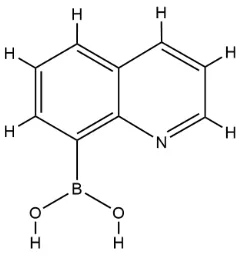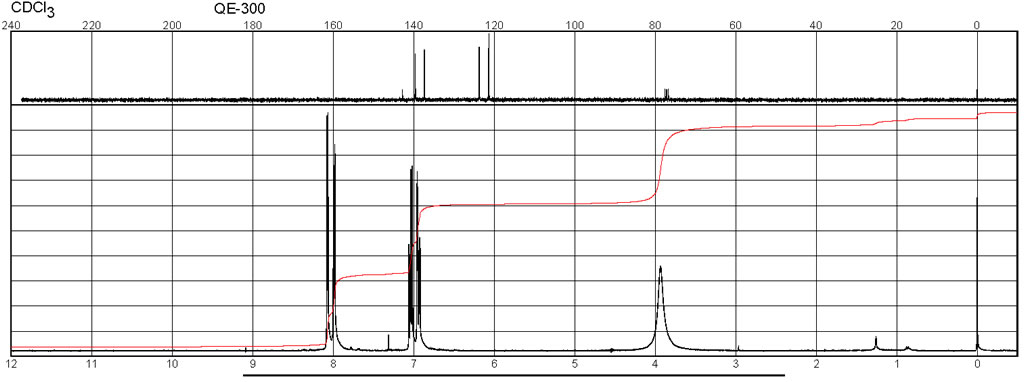8-Quinolineboronic acid CAS#: 86-58-8; ChemWhat Code: 16807
Identification
| Product Name | 8-Quinolineboronic acid |
| IUPAC Name | quinolin-8-ylboronic acid |
| Molecular Structure |  |
| CAS Registry Number | 86-58-8 |
| EINECS Number | No data available |
| MDL Number | No data available |
| Beilstein Registry Number | No data available |
| Synonyms | 8-quinolinylboronic acid8-quinoline boronic acidquinolin-8-ylboronic acidquinoline-8-boronic acidquinoline-8-yl boronic acid |
| Molecular Formula | C9H8BNO2 |
| Molecular Weight | 172.980 |
| InChI | InChI=1S/C9H8BNO2/c12-10(13)8-5-1-3-7-4-2-6-11-9(7)8/h1-6,12-13H |
| InChI Key | KXJJSKYICDAICD-UHFFFAOYSA-N |
| Canonical SMILES | OB(O)c1cccc2cccnc12 |
| Patent Information | ||
| Patent ID | Title | Publication Date |
| CN117285527 | Cnoline PAR4 antagonist and medical application thereof | 2023 |
| WO2008/63300 | INHIBITORS OF FATTY ACID AMIDE HYDROLASE | 2008 |
Physical Data
| Appearance | White powder |
| Solubility | No data available |
| Flash Point | No data available |
| Refractive index | No data available |
| Sensitivity | No data available |
| Melting Point, °C | Solvent (Melting Point) |
| 162 | |
| 135 – 137 | |
| ethanol |
| Boiling Point, °C |
| 251 |
| 250 – 252 |
| Density, g·cm-3 | Measurement Temperature, °C |
| 1.421 | -100.15 |
| Description (Association (MCS)) | Solvent (Association (MCS)) | Partner (Association (MCS)) |
| Association with compound | phosphate buffer | D-glucose |
| Association with compound | phosphate buffer | D-sorbitol |
| Association with compound | phosphate buffer | cis-cyclohexanediol |
Spectra
| Description (NMR Spectroscopy) | Nucleus (NMR Spectroscopy) | Solvents (NMR Spectroscopy) | Frequency (NMR Spectroscopy), MHz | Original Text (NMR Spectroscopy) |
| Chemical shifts | 1H | dimethylsulfoxide-d6 | 400 | 1H NMR (400 MHz, DMSO-cfe) d 8.90 (dd, J = 4.1 , 1.8, 1 H), 8.42 (dd, J = 8.3, 1.8, 1 H), 8.05 (s, 1 H), 8.03-8.00 (m, 2H), 7.81 (dd, J = 7.1 , 1.5, 1 H), 7.67 (dd, J = 8.1 , 7.2, 1 H), 7.56 (dd, J = 8.3, 4.1 , 1 H), 7.56 (d, J = 2.7, 1 H), 7.24-7.12 (m, 7H), 7.01 (dd, J = 8.6, 1.0, 2H), 6.74 (tt, J = 7.3, 1.1 , 1 H), 5.27 (s, 2H) |
| Chemical shifts | 13C | dimethylsulfoxide-d6 | 101 | 3C NMR (101 MHz, DMSO-cfe) d 155.3 (C), 150.2 (CH), 145.7 (C), 144.6 (C), 137.8 (C), 136.3 (CH),135.8 (CH), 135.4 (C), 133.6 (C), 132.6 (CH), 130.6 (CH), 129.2 (2CH), 128.3 (CH), 128.0 (2CH + C), 127.1 (CH), 126.9 (2CH), 126.1 (CH), 122.7 (C), 121.4 (CH), 118.8 (CH),114.9 (2CH), 66.59 (CH2) |
| Chemical shifts, Spectrum | 1H | chloroform-d1 | 400.1 | |
| Chemical shifts, Spectrum | 13C | chloroform-d1 | 128.3 |
| Description (IR Spectroscopy) | Solvent (IR Spectroscopy) | Original Text (IR Spectroscopy) | Comment (IR Spectroscopy) |
| Bands | KBr | IR (ATR) 3252, 3180, 1592, 1497, 1461 , 1228, 1003, 796, 736, 694 cm1 | |
| ATR (attenuated total reflectance), Bands | 3333 – 787 cm**(-1) |
| Description (Mass Spectrometry) |
| high resolution mass spectrometry (HRMS), electrospray ionisation (ESI), spectrum |
| liquid chromatography mass spectrometry (LCMS), spectrum |
| spectrum |
Route of Synthesis (ROS)

| Conditions | Yield |
| With potassium carbonate In water; acetonitrile | 81% |
| With dicyclohexyl-(2′,6′-dimethoxybiphenyl-2-yl)-phosphane; potassium phosphate; bis(dibenzylideneacetone)-palladium(0) In toluene at 100℃; for 15h; | 80% |
| With dicyclohexyl-(2′,6′-dimethoxybiphenyl-2-yl)-phosphane; potassium phosphate; bis(dibenzylideneacetone)-palladium(0) In toluene at 110℃; Suzuki-Miyaura Coupling; | 80% |
Safety and Hazards
| Pictogram(s) |  |
| Signal | Warning |
| GHS Hazard Statements | H315 (100%): Causes skin irritation [Warning Skin corrosion/irritation] H319 (100%): Causes serious eye irritation [Warning Serious eye damage/eye irritation] H335 (97.9%): May cause respiratory irritation [Warning Specific target organ toxicity, single exposure; Respiratory tract irritation] Information may vary between notifications depending on impurities, additives, and other factors. |
| Precautionary Statement Codes | P261, P264, P264+P265, P271, P280, P302+P352, P304+P340, P305+P351+P338, P319, P321, P332+P317, P337+P317, P362+P364, P403+P233, P405, and P501 (The corresponding statement to each P-code can be found at the GHS Classification page.) |
Other Data
| Transportation | NONH for all modes of transport |
| Under the room temperature and away from light | |
| HS Code | No data available |
| Storage | Under the room temperature and away from light |
| Shelf Life | 1 year |
| Market Price | USD |
| Druglikeness | |
| Lipinski rules component | |
| Molecular Weight | 172.979 |
| logP | 1.15 |
| HBA | 3 |
| HBD | 2 |
| Matching Lipinski Rules | 4 |
| Veber rules component | |
| Polar Surface Area (PSA) | 53.35 |
| Rotatable Bond (RotB) | 1 |
| Matching Veber Rules | 2 |
| Use Pattern |
| Suzuki–Miyaura cross-coupling reactions Acts as a boronic acid reagent in palladium-catalyzed C–C bond formation. Useful for synthesizing biaryl compounds, heteroaryl derivatives, and functionalized quinoline-based molecules. |
| Pharmaceutical intermediates |
| Serves as a building block in medicinal chemistry. Used for preparing bioactive molecules and potential drug candidates, particularly those involving quinoline derivatives |
| Ligand design & coordination chemistry The quinoline nitrogen can coordinate with metals, while the boronic acid moiety provides additional binding functionality. Useful in developing catalysts and metal-organic frameworks (MOFs). |
| Fluorescent and sensing materials Quinoline derivatives exhibit photophysical properties. 8-Quinolineboronic acid can be incorporated into sensors for detecting sugars, diols, or biological molecules due to the boronic acid’s affinity for cis-diols. Material science applications Potential precursor for functional polymers and advanced materials with both electronic and optical properties. |
Buy Reagent | |
| No reagent supplier? | Send quick inquiry to ChemWhat |
| Want to be listed here as a reagent supplier? (Paid service) | Click here to contact ChemWhat |
Approved Manufacturers | |
| Caming Pharmaceutical Ltd | http://www.caming.com/ |
| Want to be listed as an approved manufacturer (Requires approvement)? | Please download and fill out this form and send back to approved-manufacturers@chemwhat.com |
Other Suppliers | |
| Watson International Limited | Visit Watson Official Website |
Contact Us for Other Help | |
| Contact us for other information or services | Click here to contact ChemWhat |


